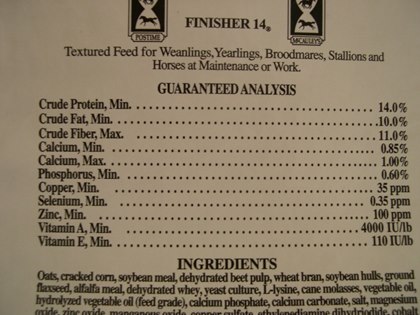Nothing in equine nutrition is simple. When you take a look at your feed tag, it rarely indicates how many calories are in the feed. If you get your hay analyzed, you are left with a list of nutrients and “normal ranges” but with no understanding of what these are.
The following are some key terms in equine nutrition (this does not include all of the information on any analysis or tag, just some of the key ones):Simple carbohydrate fractions are another important part of equine nutrition, in part because of their ability to cause gastric upset. Some carbohydrate fractions are listed below:
- Acid detergent fiber (ADF)—A measure of fiber consisting mainly of cellulose and lignin. Cellulose is fermentable by microbes in the large intestine to generate some energy while lignin is entirely indigestible. Because of this, as the ADF value of a feed goes up, its digestibility is reduced.
- As fed basis—The nutrition breakdown of a feed based as is. In contrast to feeds expressed as a dry matter basis in which the water portion has been removed.
- Ash—The total mineral content of the feed.
- Crude fiber—A measure of fiber commonly used in grain analyses.
- Crude fat—The amount of fat in the feed, also called ether extract (EE).
- Crude protein (CP)—Estimated protein in the feed from the amount of nitrogen in the sample (nitrogen x 6.25 = crude protein). Includes non-protein nitrogen sources.
- Dry matter basis—The nutrient breakdown of a feed with the water fraction removed. For example, if a feed such as hay has 10% water (the hay is 90% dry matter) and 15% protein on a dry matter basis, the amount of protein in each flake “as fed” is 14.4% (15 x .90).
- Macrominerals (major minerals)—Calcium (Ca), phosphorus (P), magnesium (Mg), sulfur (S), potassium (K), and sodium (Na).
- Microminerals (minor or trace minerals)—For example: iron (Fe), zinc (Zn), copper (Cu), selenium (Se), and manganese (Mn). These are often expressed as parts per million (mg/kg).
- Neutral detergent fiber (NDF)—A measure of fiber consisting of hemicellulose, cellulose, and lignin. Hemicellulose is well fermented by microbes (cellulose and lignin described above). As NDF goes up, intake of the hay is reduced.
- Ethanol soluble carbohydrates (ESC)—Includes simple sugars.
- Fructan—A type of carbohydrate indigestible in the small intestines but readily fermented in the large intestine. It is associated with laminitis when consumed in high amounts. Fructan concentrations are highly variable in pasture, with higher concentrations in the spring and fall and at the end of a sunny day (they are produced with photosynthesis). Horses sensitive to simple carbohydrates (for digestive or metabolic purposes) should avoid late afternoon pasture.
- Non-fiber carbohydrates (NFC)—Includes starch, simple sugars, and fructans.
- Non-structural carbohydrates (NSC)—The fraction of a feed that contains mostly simple sugars and fructans. It is recommended that horses sensitive to glucose in their diet (for mental, digestive, or metabolic reasons) be fed a low (less than 10%) NSC diet.
- Starch—A polysaccharide well digested in the small intestine, though at higher intakes it may reach the large intestine where it is fermented rapidly and may cause colic or laminitis.
- Water-soluble carbohydrates (WSC)—Includes NSC and starch.
- Taken from TheHorse.com
- Written by Shannon Pratt-Phillips, MSc, PhD


 RSS Feed
RSS Feed
